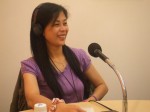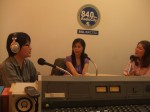We tried to bring you a story in both English and Japanese as much as possible. So if you don’t understand any Japanese, you might have felt that we had a chat in Japanese too much. But I would like you to disregard it or to see how it’s done.
今週から、少し日本語の割合を増やしてみました。とは言え、ラジオインタビュー中はずっと英語だったじゃないか!とお叱りを受けそうですが、番組後半の一番アタマで日本語での解説を行っています。このページの一番上にあるプレイヤーでお聴きになる際は、12’25″あたりから日本語の解説が入りますので、それまではどうか、英語でのトークを楽しんでいただければと思います。
By the way, we had a radio interview with an American woman over the phone. Her name is Leah Dubuc Muega and now she lives in Adachi-ku, located north of the heart of Tokyo. She came to Japan in 2005 and taught English in Yamagata Prefecture, a part of Tohoku area. Then Leah went back home to Michigan to finish college. And she returned to Japan in 2008 and became an English teacher again.
So click the player at the top of this page and listen to her childbirth experience in the country, where her language is not spoken in.
今週は中央区から少しだけ離れた足立区にお住まいのアメリカ人と電話をつないでのインタビューでした。マヤさんのご友人のリア・デュブク・ムエガさんです。2005年に来日し、山形県で英語を教えた後に一時帰国し大学を卒業、その後2008年に再来日して今に至ります。現在も英語を教えています。
日本の病院は、まだまだ英語が通じないところが多いようです。 そんな国で、彼女は子どもを授かりました。さて、リアさんはどんな行動を取ったのでしょうか。ヒントは”midwife”または”midwifery”です。その答えについては、このページトップにあるプレイヤーで12’25″以降をお聴きくださいね。
Then, here’s a recommendation from Leah. The maternity center where she gave birth at is;
Matsugaoka Birth Center (Nakano-ku, Tokyo) http://midwife.blush.jp/matsugaoka/e/index.html
They have 6 rooms (3 are Japanese-styled, another 3 rooms are Western-styled) and 2 birthing rooms (1 with a pool and 1 with tatami mats). They serve you very healthy and macrobiotic Japanese food. Ms. Sou, the clinic director, can speak English (Midwives can not). She said, “If I had to do again, I would go to the same midwifery clinic.”
And… her husband, who speaks some Japanese, took care of her very much. He’d been with her all the time during the birth and gentled on Leah’s back. That must be a really, really big help ! An English proverb “Love makes one fit for any work” was proved!
英語が通じない中で彼女が選んだのは、中野区にある「松が丘助産院」(http://www2.odn.ne.jp/~cdk23230/)でした。ベッドや布団を備えた部屋が6つあり(和室3・洋室3)プールまたは畳の部屋での出産が可能。食事は健康的でマクロビオティックな和食とのことで、リアさんは「また出産することがあれば、絶対に松が丘助産院さんにお世話になる!」と言っています。
*以下は日本語でカバーしている内容ですので、英語だけの表記とさせていただきます。

Maya got involved in Leah’s childbearing. Leah wanted to give birth to a baby at her home because she wanted to control the situation of having her baby. She was afraid that she wouldn’t understand Japanese doctors or nurses and everything was going on. So she thought, “If I have birth at my own house, I would understand everything.” So she wanted an English-speaking midwife.
Then she asked Maya to find a midwife or to interpret what a midwifery said and pass those on to Leah. But Maya opposed her idea because she had to have so much responsibility. Moreover her family disagreed with her plan. So Leah decided to a midwifery clinic instead of searching a midwife.

Also Arlene has had a similar experience. When she gave birth to her first baby here in Tokyo about 16 years ago, she knew almost nothing about where hospitals are and how Japanese insurances apply to her case. Her Japanese skills were lower than the current level, so she couldn’t catch a lot of technical terms that doctors and nurses were using. There were no translation service, or nobody told her about it at that time.
Arlene has much experience of getting lost in translation in daily life in Japan, that’s why she provided you some informations regarding medical issues such as http://fm840.jp/blog/myeyestokyo/?p=2445 and http://fm840.jp/blog/myeyestokyo/?p=2447.
My Eyes Tokyo wants to help women or those who get lost in translation like this case!
このように、言葉の壁に阻まれて困っている女性の方、それだけでなくいろんな方々に対し、My Eyes Tokyoが力になれるようになれたらと思います!
